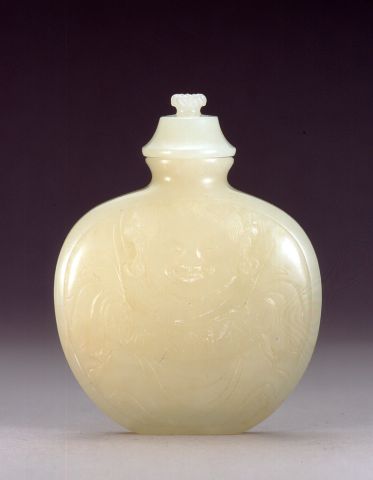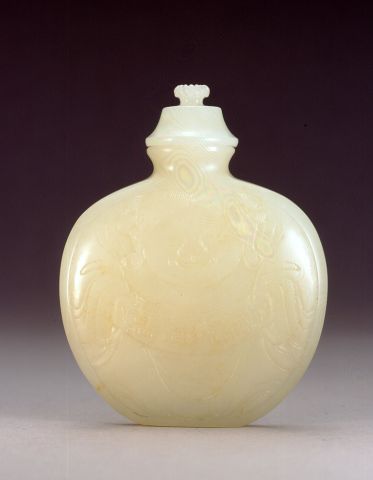


Bottle ID: 384
SPHERICAL, CARVED FAT BOYS
Date: 1740-1820
Height: 59 mm
Nephrite, greenish-white, well hollowed, of flattened circular form with shoulders tapering to a flared neck, and with a neatly carved footrim, carved in low relief on both sides with a fat youth, with long hair tied up on either side of his head, earrings and voluminous robes, holding a banner with an inscription, one side reading: Jie’er jingfu (‘to borrow good fortune from you’), the other reading: Suiwomei shou (‘for my own long life’). Together with an original matching nephrite stopper in the form of an ‘official’s hat’ with an integral finial carved as a rope.
Probably Imperial, attributed to the Palace Workshops, Beijing.
Similar Examples:
Sotheby's, London, June 21, 1995, lot 1, Collection of the Stone Picking Studio [Cai Shi Xuan] [glass]
Provenance:
Hugh Moss [HK] Ltd.
The Franz Collection
Sotheby's, New York, October 25, 1997, lot 67
Gerry P. Mack
A version of this subject painted by Leng Mei, the Kangxi Court Artist, was offered by Christie’s, New York, 27th April, 1997. The figure there has a clearly painted bald pate which is not so visible on the carved bottle as it is obscured by the frame. The similarities may suggest that the figures on the bottle are Buddhist deities, and perhaps associated with Shi De and Han Shan, two Buddhist monks of the Tang dynasty. These two in turn are associated with the He He twins of later mythology, making it likely that the carver and his target audience would have perceived these two as the He He twins, the patrons of commercial enterprise. This seems sensible given the two inscriptions, particularly the borrowing of good fortune.
The Imperial attribution is based upon the form, which was a common late Qianlong shape for Imperial snuff bottles in both jade and porcelain, and the matching stopper of ‘official’s hat’ shape, a standard at Court, but rarely seen elsewhere. The rope border at the top of the stopper is highly unusual for snuff bottles but is seen more typically as a Qianlong Imperial decorative motif.
< Back to full list

 English
English 中文
中文